What is the Amoeba defense
The Amoeba defense is a basketball defensive strategy that seeks to limit scoring opportunities for the offensive team by implementing on-ball pressure as well as sideline traps while preventing dribble penetration from the perimeter and restricting entry passes into the high or low post areas.
Additionally, the Amoeba defense encourages defensive interceptions that could potentially lead to easy fast break points created from live-ball turnovers.
Furthermore, the Amoeba defense was notably utilized by Coach Jerry Tarkanian, particularly during his time as the head coach of the UNLV men’s basketball team.
What is an example of the initial formation for the Amoeba defense
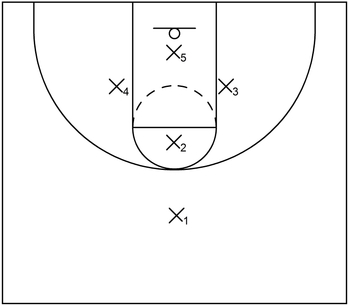
This is an example of the initial formation for the Amoeba defense. X1 starts at the extended top while X2 starts near the high post area.
X3 and X4 start near the mid-post areas between the high post elbows and low post blocks. X5 starts in front of the basket.
What are the general responsibilities of the defenders within the Amoeba defense
The responsibilities of X1 are to pressure the offensive player with the ball at the top once that same player crosses the half court line, cover the high post area, set traps, or intercept passes near the high post or wing areas.
The responsibilities of X2 are to cover the high post area, protect the lane slightly below the free throw line, guard the weak side wing area on skip passes, cover the top on ball reversal, and prevent middle dribble penetration in some instances.
The responsibilities of X3 and X4 are to cover the wing areas, intercept passes near the low post, set traps near the wings or corners, or potentially cover the weak side wing areas on skip passes.
The responsibilities of X5 are to protect the basket, guard against an offensive player near the low post block on ball side, closeout to the corners to prevent a possible uncontested jump shot, or occasionally intercept passes to the corners.
What is an advantage of the Amoeba defense
One notable advantage of the Amoeba defense is that it uniquely features a combination of basketball defense systems such as man to man defense, zone defense, as well as trap defense tactics to disrupt the flow of the offense.
For example, each one of the defenders could potentially execute on-ball man to man defense, particularly near the perimeter.
If that occurs, then the other four off-ball defenders will essentially play zone defense by covering specific areas on the court.
However, it is also possible for any one of those particular off-ball defenders to intercept passes by stepping into certain passing lanes or generate traps near the sidelines, which is typically utilized in full court presses or half court trap defenses.
What is a disadvantage of the Amoeba defense
One particular disadvantage of the Amoeba defense is that each defender needs an adequate amount of lateral quickness and general footspeed in order to efficiently pressure the ball, execute closeouts, or generate steals via interceptions.
For example, if an offensive player is in possession of the ball and a defender is currently guarding that offensive player without an ample amount of lateral quickness, then this could potentially allow the offensive player with the ball to beat that defender off the dribble and create penetration, particularly towards the lane.
This, in turn, would effectively break down the defense and create scoring opportunities for the offense.
Additionally, if the offensive team moves the ball, particularly alongside the perimeter, but one or more of the defenders do not have an acceptable amount of footspeed to closeout properly, then it is possible that the offensive team might be able to take an open jump shot or dribble drive around the slower defender.
Furthermore, if a defender gambles for a steal but that same defender was not quick enough to intercept the ball in time, then that would most certainly put the Amoeba defense out of proper formation.
When that occurs, the offensive team could have a temporary numbers advantage, which, in turn, could lead to scoring opportunities near the basket or from the perimeter.
What are examples of the Amoeba defense
Example 1
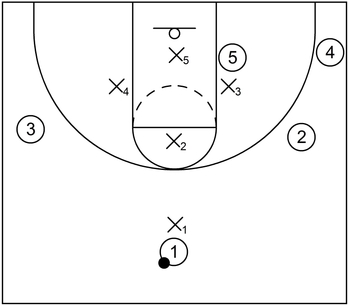
This is an example of the Amoeba defense when the ball is at the top. X1 extends defensive pressure once 1 crosses the half court line. The other four defenders stay in the initial areas until the ball gets passed to another location on the court.
Example 2
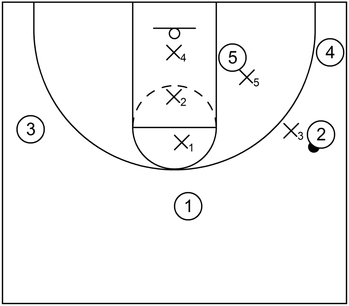
This is an example of the Amoeba defense when the ball is on the wing. X3 executes a closeout and extends defensive pressure on 2.
Next, X1 drops back near the high post above the free throw line and X2 also drops back into the lane below the free throw line.
X5 fronts the high post and prepares to closeout to the corner if necessary. X4 drops back into the lane to protect the basket from potential weak side cutting actions.
Example 3
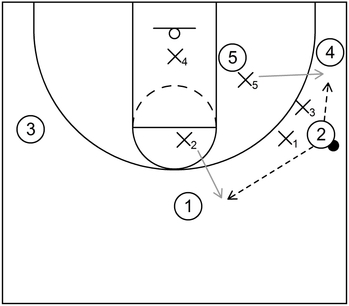
This is an example of the Amoeba defense when the ball gets trapped near the wing. To start, X1 sprints over to trap the ball alongside X3. Afterwards, 2 will probably attempt to pass out of the trap.
If that occurs and 1 is to be the recipient of that pass, then X2 has the option to intercept the ball, represented by the gray arrow.
On the other hand, if 4 is to be the recipient of that pass, then X5 has the option to intercept the ball, shown with the gray arrow.
Example 4
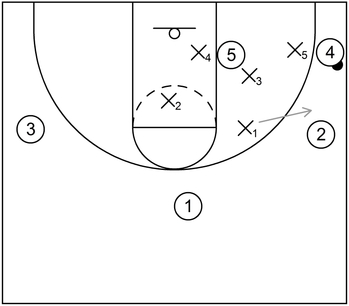
This is an example of the Amoeba defense when the ball gets into the corner. If that occurs, then X5 executes a closeout to prevent an uncontested jump shot.
X3 drops back to front the low post so that 4 cannot make the easy post entry pass. Also, X1 has the option to intercept or deny the possible pass to the right side wing, represented by the gray arrow.
X4 slides over to guard 5 while X2 stays in the lane to mitigate basket cuts by 1 or 3.
Example 5
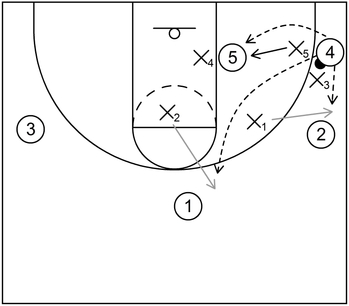
This is an example of the Amoeba defense when the ball gets trapped near the corner. X3 sprints over to trap the ball alongside X5.
Following that, 4 will most likely attempt to pass out of the trap. If that happens and 2 is to be the recipient of that pass, then X1 has the option to intercept the ball, shown with the gray arrow.
On the other hand, if 1 is to be the recipient of that pass, then X2 has the option to intercept the ball, as represented by the gray arrow.
Furthermore, if 5 is able to receive the ball out of the trap, then X5 could double team the low post alongside X4.
Example 6
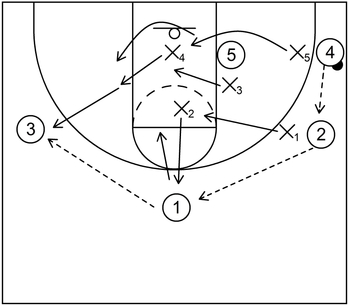
This is an example of the Amoeba defense when the ball gets reversed from one side of the court to the other side. When 2 receives the ball from 4, X1 will temporarily closeout to prevent the jump shot or middle dribble penetration.
When 1 receives the ball from 2, X2 will closeout while X1 drops back into the lane, X3 stays near the right side mid-post area, X4 steps up to the left side mid-post area, and X5 begins to step in front of the basket.
When 3 receives the ball from 1, X4 executes a closeout on the ball, X2 drops back to the high post area above the free throw line, X1 stays in the lane below the free throw line, X3 protects the basket, and X5 covers the left side low post area.
Example 7
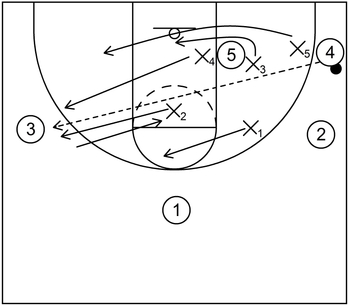
This is an example of the Amoeba defense when the ball gets skipped from the corner to the wing. When that occurs, X2 sprints out to temporarily closeout on the ball.
At the same time, X4 also sprints to the ball and bumps X2 back to the lane below the free throw line.
Also, X1 covers the high post above the free throw line while X3 protects the basket and X5 covers the left side low post area.
Example 8
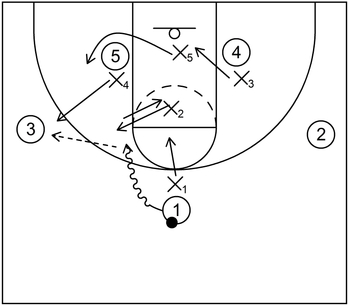
This is an example of the Amoeba defense when middle penetration occurs from the top. If that happens, X2 will step into the driving lane of the ball handler to stop the penetration.
If 3 receives the ball, then X4 executes a closeout, X2 drops back into the lane below the free throw line, X1 drops back to the high post above the free throw line, X5 fronts the low post on ball side, and X3 protects the basket.
What are associated basketball defenses that are used within the Amoeba defense
Man to man defense is a type of basketball defensive system comprised of various defenders that guard certain offensive players, typically based on their respective basketball positions, to ultimately limit or prevent scoring opportunities near the basket or from the perimeter.
Zone defense is a type of basketball defensive system featuring multiple defenders that guard a certain area on the court and by extension, any offensive player that enters into that zone defender’s respective area.
Trap defense is a basketball defensive tactic consisting of two defenders that effectively double team an offensive player with the ball, typically near a sideline and/or corner of the court.